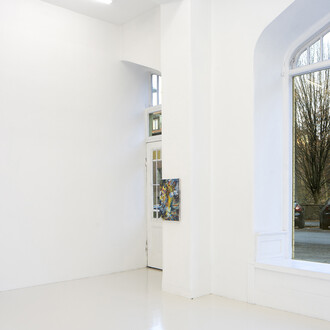Jordan Wolfson is currently one of the most exciting young artists on the American art scene right now. Experience the intense visual world of the video sculpture “Riverboat Song”, where animated characters run amok amid pop music and clichéd clips from the internet.
Wolfson’s latest video “Riverboat Song” (2017–18), was recently added to the Museum’s collection. This video sculpture mixes computer-animated scenes with found clips from the less savoury sides of the internet, loops of pop music and a monologue by the artist himself. The boyish Huckleberry Finn-like protagonist recurs in Wolfson’s works, possibly as an alter ego or a symbol of the American Dream – searching for happiness, adventurous, free. The characters in his often technically advanced sculptures and animations are both fascinating and challenging, often leaving us with a sense of unease.
What might seem like an entertaining flow of randomly arranged imagery in “Riverboat Song” – computer animations, music, garnered partly from popular and internet culture – are, in fact, meticulously composed scenes that put us off balance. Wolfson’s manipulation of the apparently familiar puts trust between sender and receiver to the test.
The artist himself describes that his compass when creating a new work is the search for a specific, real feeling. The road to that experience can be humour, dramaturgical short circuits and a degree of shock.
Wolfson is one of the most exciting young artists on the American art scene right now, whose norm-breaking works occasionally cause outrage, for instance, at the Whitney Biennial in 2017, where he provoked debate when he presented “Real Violence”, a VR work where viewers witness a re-enacted violent assault. He is considered to belong to a movement in art that is sometimes called “post-internet”, which comments on and is inspired by a digital information and consumer society.
Jordan Wolfson finds his reference points in various fields, including the Hollywood movie industry, with its special effects illusions and capacity to manipulate. Production is time-consuming, expensive, and relatively small, and can be seen as a series of works that are “released” one by one, like films or novels.
Wolfson is known, among other things, for his use of animatronics – a form of jointed robots that can be used for stunt tricks, which Wolfson has programmed with face recognition technology so they can interact with the audience. As in “(Female Figure)” (2014), a monstrous dancer fastened to a mirror, who is both seductive and terrifying. Or, as in “Colored Sculpture” (2016), where a puppet suspended by chains from a gantry system is subjected to a series of mechanical assaults, only to challenge us by uncannily seeking eye contact.
Jordan Wolfson was born in New York in 1980 and now lives in Los Angeles. His works have been shown at Tate Modern, London, S.M.A.K., Ghent, The Broad, Los Angeles, and the Stedelijk Museum, Amsterdam. He has a BFA in Sculpture from the Rhode Island School of Design in New York. He also studied for one year at the Konstfack University College of Arts, Crafts and Design in Stockholm.















